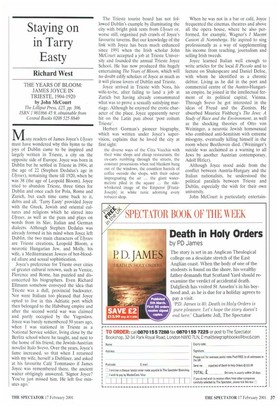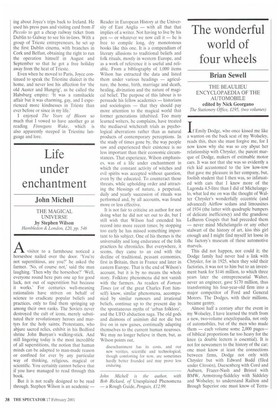Staying on in Tarry Easty
Richard West
THE YEARS OF BLOOM: JAMES JOYCE IN TRIESTE, 1904-1920 by John McCourt The LiInput Press, £25, pp. 306, ISBN] 901866 45 9, obtainable from Central Books 0208 525 8840 Many readers of James Joyce's Ulysses must have wondered why this hymn to the joys of Dublin came to be inspired and largely written in Trieste, a city on the opposite side of Europe. Joyce was born in Dublin but he settled in Trieste in 1904, at the age of 22 (Stephen Dedalus's age in Ulysses), remaining there till 1920, when he was 38 (the age of Leopold Bloom). Joyce tried to abandon Trieste, three times for Dublin and once each for Pola. Rome and Zurich, but each time came back to it, debts and all. 'Tarty Easty' provided Joyce with the Greek, Jewish and oriental cultures and religions which he stirred into Ulysses, as well as the puns and plays on words from its Slav, Italian and German dialects. Although Stephen Dedalus was already formed in his mind when Joyce left Dublin, the two main characters of Ulysses are Trieste creations, Leopold Bloom, a neurotic Hungarian Jew. and Molly, his wife, a Mediterranean Jewess of hot-blooded allure and sexual sophistication, Joyce's preference for Trieste over cities of greater cultural renown, such as Venice, Florence and Rome, has puzzled and disconcerted his biographers. Even Richard Ellmann somehow conveyed the idea that Trieste was a dull, provincial backwater. Nor were Italians too pleased that Joyce opted to live in this Adriatic port which then belonged to the Habsburg empire and after the second world war was claimed and partly occupied by the Yugoslays. Joyce was barely remembered 50 years ago, when I was stationed in Trieste as a National Service soldier, living close by the Berlitz school where he taught, and next to the home of his friend, the Jewish-Austrian novelist Italo Svevo. Over the years, Joyce's fame increased, so that when I returned with my wife, herself a Dubliner, and asked at his favourite Café Tommaseo if James Joyce was remembered there, the ancient waiter obligingly answered. 'Signor Joyce? You've just missed him. He left five minutes ago.'
The Trieste tourist board has not followed Dublin's example by illuminating the city with bright pink texts from Ulysses or, worse still, organised pub crawls of Joyce's favourite taverns. But our knowledge of the link with Joyce has been much enhanced since 1991 when the Irish scholar John McCourt accepted a job at Trieste University and founded the annual Trieste Joyce School. He has now produced this hugely entertaining The Years of Bloom, which will no doubt edify scholars of Joyce as much as it will please lovers of Dublin and Trieste.
Joyce arrived in Trieste with Nora, his wife-to-be, after failing to land a job at Zurich but having already consummated what was to prove a sexually satisfying marriage. Although he enjoyed the erotic character of the place, Joyce apparently never hit on the Latin pun about 'post coitum Trieste'.
Herbert Gorman's pioneer biography, which was written under Joyce's supervision, explains that he loved the city at first sight:
the diverse ways of the Citta Vecchia with their wine shops and cheap restaurants, the Ox-carts rumbling through the streets, the constant processions when red blankets hung out of the windows, the countless barrels of coffee outside the shops, with their odour impregnating the air ... the giant watermelons piled in the square ... the sidewhiskered image of the Emperor [FranzJoseph] in white tunic adorning every tobacco shop.
When he was not in a bar or café, Joyce frequented the cinemas, theatres and above all the opera house, where he also performed, for example, Wagner's 1 Maestri Canton i di Norimberga. He aspired to sing professionally as a way of supplementing his income from teaching, journalism and selling Irish tweeds.
Joyce learned Italian well enough to write articles for the local II Piccolo and to lecture on Shakespeare and Daniel Defoe, with whom he identified as a chronic debtor. Living as he did in the port and commercial centre of the Austro-Hungarian empire, he joined in the intellectual ferment of its political capital, Vienna. Through Svevo he got interested in the ideas of Freud and the Zionists. He absorbed Maurice Fishberg's The Jews: A Study of Race and the Environment, as well as the shocking theories of Otto von Weininger, a neurotic Jewish homosexual who combined anti-Semitism with extreme misogyny, eventually killing himself in the room where Beethoven died. (Weininger's suicide was acclaimed as a warning to all Jews by another Austrian contemporary, Adolf Hitler).
Although Joyce stood aside from the conflict between Austria-Hungary and the Italian nationalists, he understood the political parallels between Trieste and Dublin, especially the wish for their own university.
John McCourt is particularly entertain ing about Joyce's trips back to Ireland. He used his press pass and visiting card from II Piccolo to get a cheap railway ticket from Dublin to Galway to see his in-laws, With a group of Trieste entrepreneurs, he set up the first Dublin cinema, with branches in Cork and Belfast, obtaining the right to run the operation himself in August and September so that he got a free holiday away from the heat of Trieste.
Even when he moved to Paris, Joyce continued to speak the Triestine dialect in the home, and never lost his affection for the old Auster and Hungrig', as he called the Habsburg empire: It was a ramshackle affair but it was charming, gay, and I experienced more kindnesses in Trieste than ever before or since in my life.'
I enjoyed The Years of Bloom so much that I vowed to have another go at reading Finnegans Wake, which is also apparently steeped in Triestine language and lore.



































































 Previous page
Previous page